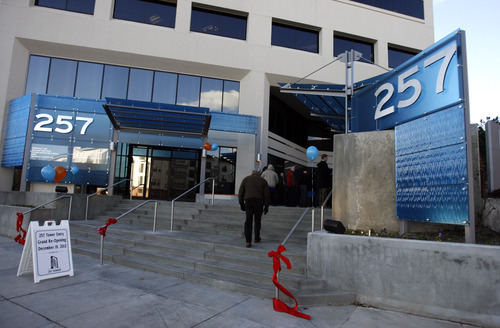This is an archived article that was published on sltrib.com in 2013, and information in the article may be outdated. It is provided only for personal research purposes and may not be reprinted.
Salt Lake County's mutifaceted commercial real estate industry — made up of retail, industrial, office and apartment markets that don't always move in tandem — is entering the new year in better shape than in a long time.
It's not back to 2007, when industries were humming and the recession was yet to hit in full force. But many of the components that the commercial real estate sector uses to measure the sector's vigor have stabilized over the past two years, and 2013 shows signs of shaping up nicely.
"The market feels like it's definitely improving," Scott Lovell, Salt Lake City -based regional research director of Cushman & Wakefield Commerce, said Friday. "I don't think anybody will be upset with 2013. It's going to be a good year."
Last week, the commercial real estate and consulting firm released its annual review of commercial real estate action in Utah's biggest counties. Although the office, industrial and real estate markets are each driven by different factors, the overall level of activity suggests that the industry is returning to normal long-term performance levels.
"I think that all segments of our commercial real estate market place are in recovery, and multifamily (apartments) is probably the strongest. It's very solid. It almost appears that it's better" than ever, said Michael Jeppesen, president of IPG Commercial Real Estate in Salt Lake City.
Commercial activity is strong enough that Steve Tobias, director of Keller Williams Commercial in Salt Lake City, wants to hire another partner or two to help expand his company's business. Tobias's 15 agents are all reporting higher sales, and "I'm about as busy as I want to be," he said.
For consumers, retail is king, and the retail vacancy rate in that sector of Salt Lake County's market fell last year to 8.8 percent, close to the 10-year average of 8.4 percent. Pushing the rate down has been strong consumer spending, helped by the opening of City Creek shopping center in March, and of Scheels, the 220,000-square-foot sports store in Sandy, in September.
Lease rates continued a long-term downward trend in 2012, from close to $21 a square foot in 2008 to about $17 last year, but Cushman expects that rents will move slightly higher this year and that vacancy rates across various types of retail categories will fall further.
"Overall, 2013 will be steady, as existing properties look to create higher occupancy," the Cushman report said.
Lovell said the industrial real estate market is largely driven by population growth, and Utah has had one of the fastest-growing populations in the U.S., even during the recession. That's pushed sales and leasing activity to the highest levels since the mid-1990s. Although the vacancy rate rose to 9 percent last year, it was still just 1 percentage point above the 10-year average of 8 percent, he said.
Industrial construction bottomed out in 2009, at 862,508 square feet. Since then, construction has risen steadily, reaching almost 2 million square feet last year. New construction in 2013 is expected to exceed last year. Most construction projects will be larger than 100,000 square feet, reflecting the growing interest that companies outside Utah have in the state.
Overall, industrial real estate activity in Salt Lake County is expected to increase through the year and into 2014 for both leasing and sales, with prices rising, as well.
"Industrial is really at a good equilibrium point. There are spaces for tenants to take, and tenants are taking them. If we are out of equilibrium we [would] see rents softening, and we are not seeing that now," Jeppesen said.
Job growth drives the office real estate market, and Utah's job growth rate is one of the strongest in the country, led for more than a year by the professional and business services sector of the state' economy. Even so, office vacancies increased to 14.8 percent in 2012 from 13.8 percent in the previous year. Lovell said the increase was largely because Questar Corp. and the Federal Bureau of Investigation moved into new buildings. Roughly 827,000 square feet of new office space was built last year, more than the 10-year average of 641,000 square feet.
Builders are more optimistic because they see tenants expanding" their businesses," Lovell said.
Lease rates for office space across the county are at five-year highs. Rates should remain steady through 2013 and vacancies should hold steady, according to Cushman.
The vacancy rate for apartments in the county was 3.8 percent at the end of last year. A year earlier the rate was 5.2 percent. With demand exceeding supply, rental rates increased jumped an average of 8 percent over 2011, according to Cushman.
The tight apartment market caught the attention of "institutional quality" investors outside Utah, Jeppesen said.
"They have come back in the last six months, and will continue to be here. They are definitely interested in multifamily" properties, he said.
Across Utah, the value of properties that changed hands totaled $813 million last year, close to the 10-year average of $846 million. Lovell said values this year should be close to $1 billion.
Twitter: @sltribpaul —
The Salt Lake County commercial market, at a glance
The retail vacancy rate last year fell to 8.8 percent, close to the 10-year average of 8.4 percent
The office vacancy rate was 14.8 percent, up from 13.8 percent in 2011, but Class A lease rates were at a five-year high
Industrial vacancies totaled 9 percent, 1 percentage point higher than the 10-year average of 8 percent
The vacancy rate for apartments was 3.8 percent last year, down from 5.2 percent in 2011
Source: Cushman & Wakefield Commerce





